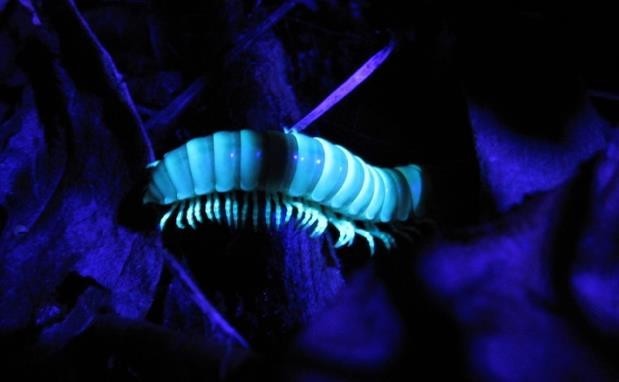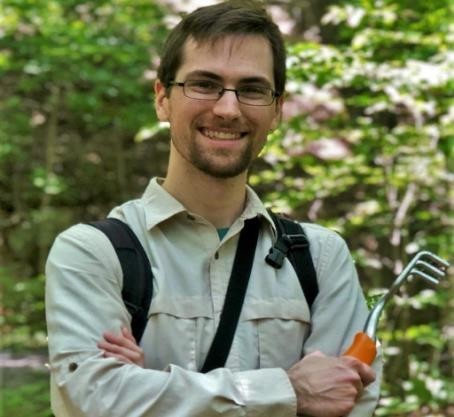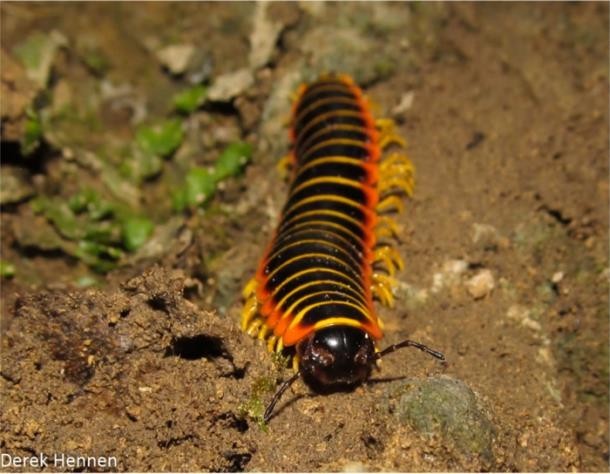Derek A. Hennen: The wondrous world of millipedes
This story was written in the spring of 2020 by GRAD 5144 (Communicating Science) student Rifat Sabbir Mansur as part of an assignment to interview a classmate and write a news story about his research.
Derek Hennen remembers the first time he examined millipedes using a hand-held UV light.
“(The millipedes) were going in and out of leaves like little stars,” he says of the blue glowing creatures.
Hennen was hooked. He finds arthropods, and especially millipedes, to be fascinating. Among all known living animal species, over 80 percent belong to Arthropoda—and yet more remain to be discovered.

A recent Ph.D. graduate of Virginia Tech, Hennen’s research is on millipede systematics, the taxonomy of the many-segmented creatures. He is trying to name previously undescribed millipedes, a task that requires following specific rules to identify, describe, and name new species—specifically, rules from the International Commission on Zoological Nomenclature. During his time at Virginia Tech, Hennen worked in collaboration with his advisor and lab mates in the Department of Entomology and Interfaces of Global Change program.
While interviewing Hennen, I found him to be very passionate about his research, especially that there are still so many new species of millipedes to be found. He told me that he was always fascinated by the organisms he saw on nature shows during his childhood.
“Millipedes lit a spark in me,” he said.
Discovering, describing, and naming new species helps researchers study new millipedes and better understand their habitats, behaviors, and conservation. Loss of habitat can cause species extinction, and identifying critical habitat is the first step in protecting it.

Millipede hunting can be a local or a far-ranging activity. Hennen has been to 20 different states in his quest to find new millipede species. He usually visits a state for one week and observes three or four sites each day. He and his teammates have camped in state forests and national parks to find new species. He has also collaborated with several millipede scientists from Brazil and China, involving himself with the global entomology community.
Finding new millipedes can be difficult. Finding the right location to search for millipedes can be challenging, Hennen explained, making it hard to find new species. Millipedes’ habitats depend on the climate, and they typically prefer cool, moist environments. Spring and fall are the best times to look for millipedes, and it is hardest to find them during dry seasons, Hennen said.
Despite the challenges, Hennen has successfully identified new species of millipedes. His most recent finding is the discovery of over a dozen new species of twisted claw millipedes. In this group of millipedes, he found several significant anatomical and genetic differences that enabled him to sort out new species. He did this by analyzing their modified legs and the differences in their DNA structure and presented his findings to the scientific community at a conference last November.
A primary misconception about millipedes, Hennen said, is that they are insects. Millipedes are NOT, in fact, insects! They are a separate class of arthropods. According to Hennen, any land animal with more than eight legs is most likely a millipede. Millipedes do not bite or sting, so they are safe to touch. And they can be found on every continent except Antarctica.
Hennen finds millipedes to be very beautiful and shared one of his favorite species, the cherry millipede, which can be found in back yards in Virginia. This species has bright red, orange, or yellow colors against a black body, which makes them look very pretty. If you shake them, Hennen said, they smell like cherries; hence their name, cherry millipedes.

Hennen majored in biology at Ohio’s Marietta College, where he became interested in ecology and animals. He also monitored water quality and streams and encouraged people to keep water clean while volunteering with Americorps*VISTA. After college, Hennen earned his M.S. in entomology at the University of Arkansas, specifically focusing on bugs that live under leaves.
For new and enthusiastic entomologists, Hennen suggests flipping over rocks and searching for new bugs. He also suggests observing the surrounding environment more and browsing websites to learn more about bugs (inaturalist.org and bugguide.net are two sites he recommends). Different species of bugs will interest different people; the important thing is to take a look at one’s environment.
“Knowing the biology of our back yards helps us to connect more with our homes and, ultimately, nature,” said Hennen.
For his future endeavors, Hennen hopes to publish all his findings from his dissertation. He also hopes to write a field guide for millipedes, as there are none currently available for enthusiastic individuals. Hennen hopes to call his field guide, “Guide to Ohio Millipedes,” based on where he grew up. Hennen also is working on a small side project to understand specific species of poisonous millipedes from an ecological and evolutionary aspect.
I hope the best for Hennen’s future journey!


